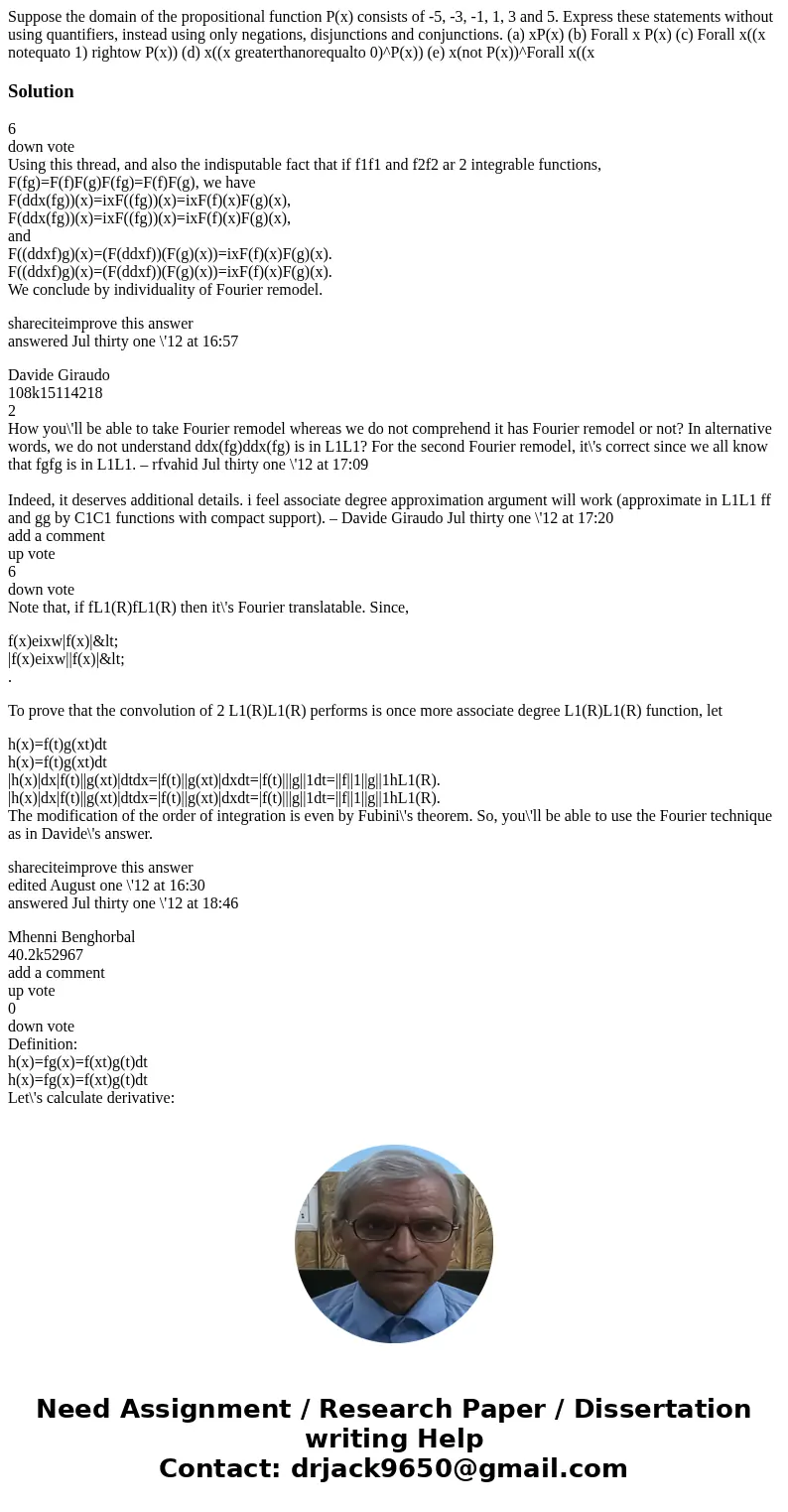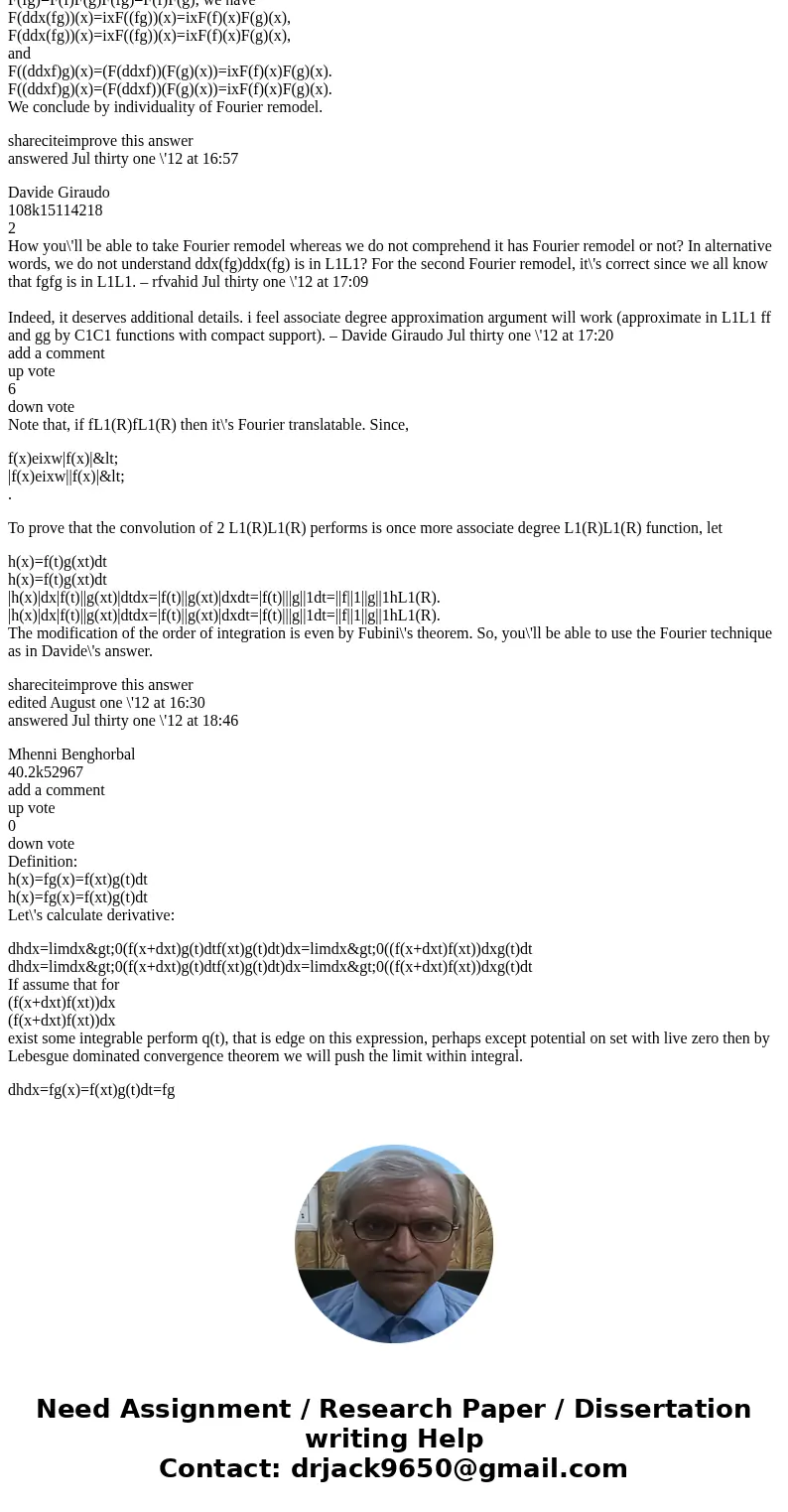Suppose the domain of the propositional function Px consists
Solution
6
down vote
Using this thread, and also the indisputable fact that if f1f1 and f2f2 ar 2 integrable functions, F(fg)=F(f)F(g)F(fg)=F(f)F(g), we have
F(ddx(fg))(x)=ixF((fg))(x)=ixF(f)(x)F(g)(x),
F(ddx(fg))(x)=ixF((fg))(x)=ixF(f)(x)F(g)(x),
and
F((ddxf)g)(x)=(F(ddxf))(F(g)(x))=ixF(f)(x)F(g)(x).
F((ddxf)g)(x)=(F(ddxf))(F(g)(x))=ixF(f)(x)F(g)(x).
We conclude by individuality of Fourier remodel.
shareciteimprove this answer
answered Jul thirty one \'12 at 16:57
Davide Giraudo
108k15114218
2
How you\'ll be able to take Fourier remodel whereas we do not comprehend it has Fourier remodel or not? In alternative words, we do not understand ddx(fg)ddx(fg) is in L1L1? For the second Fourier remodel, it\'s correct since we all know that fgfg is in L1L1. – rfvahid Jul thirty one \'12 at 17:09
Indeed, it deserves additional details. i feel associate degree approximation argument will work (approximate in L1L1 ff and gg by C1C1 functions with compact support). – Davide Giraudo Jul thirty one \'12 at 17:20
add a comment
up vote
6
down vote
Note that, if fL1(R)fL1(R) then it\'s Fourier translatable. Since,
f(x)eixw|f(x)|<
|f(x)eixw||f(x)|<
.
To prove that the convolution of 2 L1(R)L1(R) performs is once more associate degree L1(R)L1(R) function, let
h(x)=f(t)g(xt)dt
h(x)=f(t)g(xt)dt
|h(x)|dx|f(t)||g(xt)|dtdx=|f(t)||g(xt)|dxdt=|f(t)|||g||1dt=||f||1||g||1hL1(R).
|h(x)|dx|f(t)||g(xt)|dtdx=|f(t)||g(xt)|dxdt=|f(t)|||g||1dt=||f||1||g||1hL1(R).
The modification of the order of integration is even by Fubini\'s theorem. So, you\'ll be able to use the Fourier technique as in Davide\'s answer.
shareciteimprove this answer
edited August one \'12 at 16:30
answered Jul thirty one \'12 at 18:46
Mhenni Benghorbal
40.2k52967
add a comment
up vote
0
down vote
Definition:
h(x)=fg(x)=f(xt)g(t)dt
h(x)=fg(x)=f(xt)g(t)dt
Let\'s calculate derivative:
dhdx=limdx>0(f(x+dxt)g(t)dtf(xt)g(t)dt)dx=limdx>0((f(x+dxt)f(xt))dxg(t)dt
dhdx=limdx>0(f(x+dxt)g(t)dtf(xt)g(t)dt)dx=limdx>0((f(x+dxt)f(xt))dxg(t)dt
If assume that for
(f(x+dxt)f(xt))dx
(f(x+dxt)f(xt))dx
exist some integrable perform q(t), that is edge on this expression, perhaps except potential on set with live zero then by Lebesgue dominated convergence theorem we will push the limit within integral.
dhdx=fg(x)=f(xt)g(t)dt=fg


 Homework Sourse
Homework Sourse